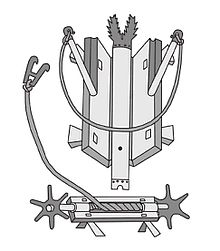Springald

A Springald, or espringal, is mechanical artillery device for throwing large bolts and less commonly stones or Greek fire. It is depicted in diagram in an 11th-century Byzantine manuscript, but in Western Europe is more evident in the late 12th century and early 13th century. It was constructed on the same principles as a Greek or Roman ballista, but with inward swinging arms. It was also known as a 'skein-bow', and was a torsion device using twisted skeins of silk or sinew to power two bow-arms.[1]
Examples have been drawn by Leonardo da Vinci, but at a time when he was also drawing powder-propelled weapons. There are no known archaeological finds of parts for these machines but it is highly likely that due to the nature of the materials used then it is probable that some material recycling took place at the time of their demise.
Reconstructions
Several reconstructed examples can be found, Jean Leibell produced a 12" model for his researches into "Springalds and Great Crossbows" which was commissioned by the Royal Armouries Museum and a larger model can be seen at the Tower of London. The only known full size example is in the Royal Armouries Museum at Fort Nelson, Portsmouth at around 8 feet long and capable of hurling a 2.4 kg Bolt over 55 metres (in excess of its expected range) and a 1.5 kg bolt over 77 metres. This example has been removed by the manufacturer, The Tenghesvisie Mechanical Artillery Society, for further research into the winding mechanism and firing tests. The machine will be returned to the museum in the spring of 2013 for a public demonstration of mechanical artillery at Fort Nelson. There also exists or existed a huge springald at Trebuchet Park, Albarracín, Spain.
Size
Although Leibell describes this size of machine as a “Great Springald”, it is more likely to be the standard size. If the evidence is investigated, such as the size of the figures in “The Romance of Alexander”,[2] where they are at about the height of the top horns, there is no evidence to suggest that they are dwarves. Although the length of the bolt to be fired may be a little on the long side.
Notes
- ^ Nicolle, pp. 173–174, the espringal is depicted, in the form of a fairly detailed diagram, in an 11th-century Byzantine manuscript
- ^ Bodleian Library, Oxford
References
- Nicolle, David (1996). Medieval Warfare Source Book Vol. II. Arms and Armour. ISBN 1-86019-861-9.
